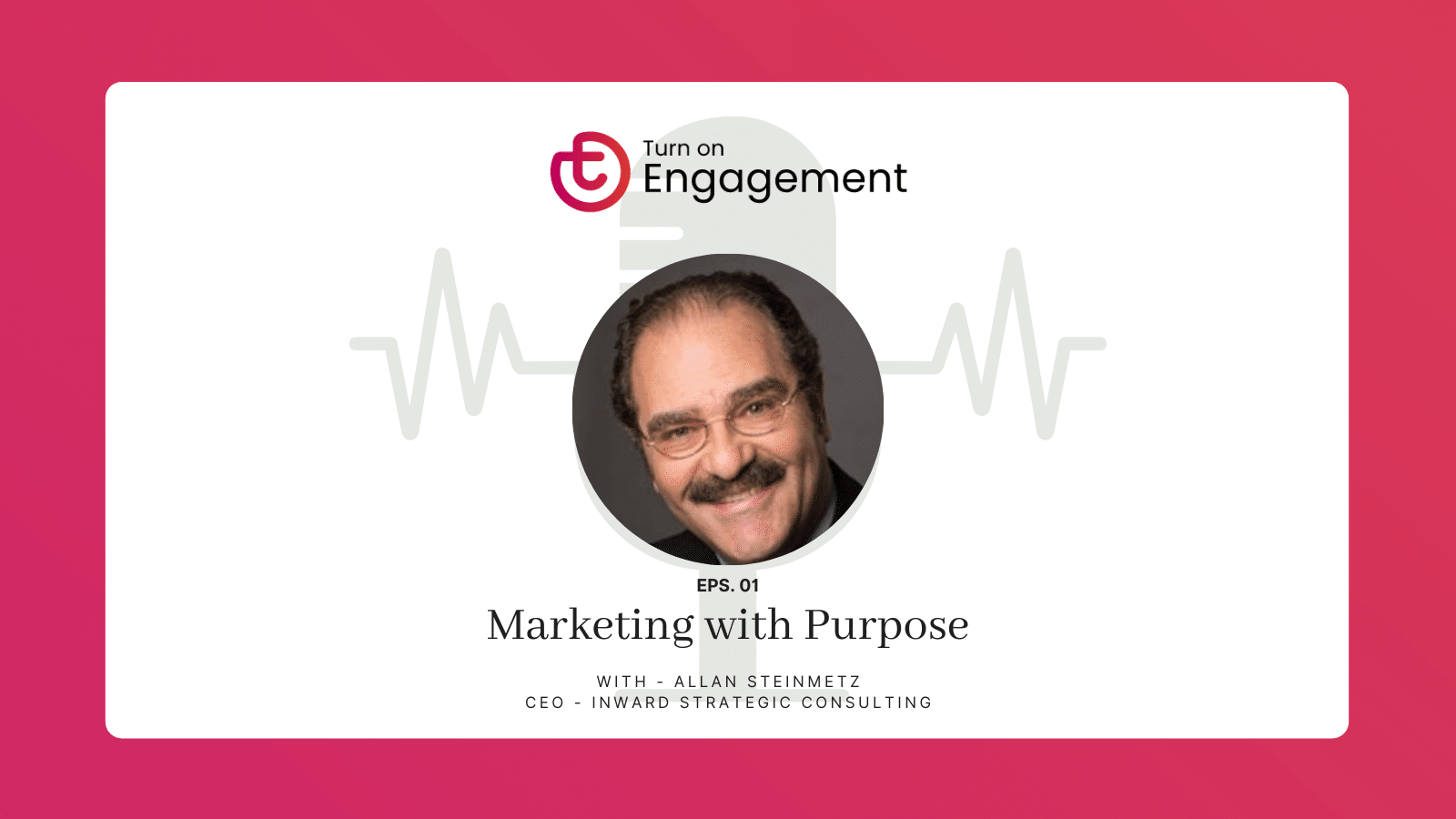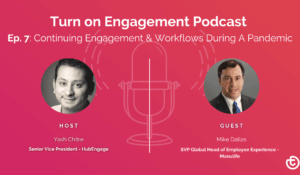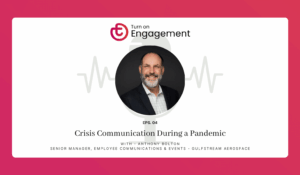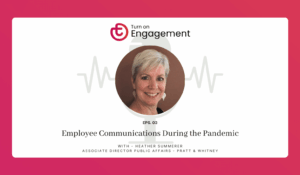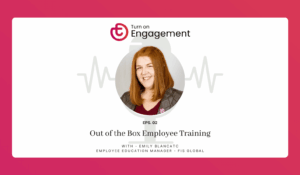Yash sits down with Allan Steinmetz, CEO of Inward Strategic Consulting for the very first episode to talk about Marketing with Purpose. A 40-year veteran in the employee engagement space, Allan shares deep insights on how legacy brands like Procter & Gamble’s marketing campaigns and why they were so effective.
Follow and listen to the Turn on Engagement Podcast on your favorite audio streaming platforms: Spotify, Google Podcasts, Apple Podcasts, Tune In, iHeartRadio, and RSS.
Podcast Transcript:
Yash Chitre: Hey there, it’s Yash Chitre from HubEngage with the Turn on Engagement Podcast. Today we’ve got Allan Steinmetz on and he’s talking about marketing with purpose and what that means to internal and external audiences. Allan is a 40-year veteran of the employee engagement space, and he shares some pretty cool insights on how some great brands out there like Procter & Gamble on getting it right today and exactly why. Hope you enjoy it.
Yash Chitre: OK welcome everybody, thanks for joining us today my name is Yash Chitre, I’m with Hubengage and today I have a very special guest with me Allan Steinmetz who is the CEO of Inward Strategic Consulting and selfishly I’ll just say that Allan is my guru, he has taught me everything I know about employee communications and employee engagement so that this was an easy podcast to do for me and it’s a pleasure for me to do.
But just to give you a little bit of a background Allan is a he’s a well-known luminary when it comes to employee engagement internal branding, and internal communications. He has a career that spans decades um, he has worked in the advertising agency world he has worked for Accenture he has led his own company he has worked with really big names like Walmart, McDonald’s, JP Morgan, too many to count so he has a lot of experience and a lot of great things to offer and one of the things that sparked my interest was the other day and wrote a piece about Procter & Gamble on his blog and if you’re interested to take a look at the links in the description below here on YouTube and also in the comments you can read it right on Inward site as well.
He talks about brand purpose connecting the internal to the external so I thought it would be great to have a quick chat here with Allan really to sort of talk about you know his story of why he decided to write about that and what does it really mean for all us folks that are in the employee engagement internal communications world so with that Allan, I’ll let you sort of take it away but tell us a little bit about the campaign about Procter and gamble what got you to it and what does it really mean.
Allan Steinmetz: Sure, first of all, thank you Yash for inviting me I, you know I love you and so accepting your invitation was really quite simple and so it’s a pleasure to be here the. In the last three years, I’ll give you a little background in the last three years there’s been a lot of emphasis around shifting from brand promise to brand purpose in fact last year the association of national advertisers had done some major research and showed that they were going to shift the definition of what brand promise is to focus more on our brand purpose.
So what is the brand purpose, the brand purpose is why you exist and there has to be an ulterior motive beyond just making money and selling more stuff, it’s more than just making a profit or shareholder value it has a higher purpose in the higher-order and when you’re able to focus on the notion of purpose over let’s say values or mission or vision or attributes of your product you’re able to differentiate yourself not only with your customer but with your employees and your sales channels simultaneously and as a result you’re able to talk about why you are in business and what you are there for, in such a way that you are able to achieve a much greater emotional connection with your customers, with your employees and your sales channel and what and that’s why it’s really important and there’s been a shift through that direction and I’ll give you some examples of that as well.
So, I’ve been very keen to be watching for companies who are focusing on purpose, and in the last few years and Procter & Gamble as you well know, Yash is a really a conglomerate of several hundreds of different brands from Thai to Gillette and all too often those companies really focus on the features and attributes of those brands you know Tide talks about fresher, whiter cleaning.
Gillette talks about the shave and the and the and the formulas of their of their lotions and what have you but they don’t have a an ultimate higher purpose and what’s the effect that it has on the business overall and so when they launched this campaign to focus on love it was like wow what the hell is that and so it basically shows the campaign itself shows us a bunch of babies one after another just giggling yet with keywords that represent what they stand for and at the end of the day it’s all about love and that Procter and Gamble is a company that brings you products that allows you to love each other and love the things that are important in your life and when you understand that and embrace it really has a huge impact as a motor supper ending for running your business and in the case of Gillette I mean it’s a case of Procter & Gamble in this particular case.
I think a large part of it has to do with the train changeover from COVID they’re basically challenging all of their customers their employees and the sales channel to do 2021 deeds of love that they could extend out to their community as a whole and I just think it’s brilliant and they’re not the only company that has done that in the last few years there are others that I can reference as well, does that make sense to you?
Yash Chitre: It does and it’s really interesting how these companies can get into the creative part of it too so you know at a very high level they know what they need to do right in terms of you know connecting the brand but then creatively how do you show that right and you know you were talking about you know 2021 and you know 2021 ways of showing love and presumably maybe they’re doing some stuff around the employee engagement side of that and collecting those stories and having them do their employees show that kind of stuff and maybe they’ll turn that into some sort of programming that they use internally to connect the brand.
And then maybe it’ll go externally to who knows maybe in a year we’ll see some of that absolutely I think that that will be really cool so you know I think companies that can obviously take something as top of mind like COVID and think it affects everybody globally but then really kind of show how their company plays a role in that and then what do their employees do to you know to not only promote the brands and the products and services that the company sells itself but actually show the world that they care that they’re listening as well I think that’s a bit that’s a big part of it too so it’s.
Allan Steinmetz: Yeah and that there’s a proactive change and a transformation that the company is doing something different that’s a critical component of this it’s not just doing it for the sake of doing it but it’s doing it because it’s a new way of conducting business that shows that you have a higher heightened reason for doing having a purpose that helps society as a whole whether it be social justice or equity or whatever I think me two movement and social justice with the Asian community and all those things play a role but it’s we’re talking about we’re talking at a higher level of purpose.
One of the things that have come up actually is there is there seems to be all some confusion between cause related marketing and purpose driven marketing also and there is a distinction, we’re not talking about making charitable or doing good in your community as well in in exclusively but it’s really that sometimes has an impact or consequence of it but it’s really trying to find out what a greater purpose another example that I just absolutely love it’s Dove, you know the soap company, they’re doing a wonderful campaign that talks about human beauty inner beauty and their goal and as a company is to bring out the inner beauty of their customers and their employees and their child and their sales organization and inner beauty doesn’t just mean a complexion it’s feeling proud about yourself and being feeling satisfied about yourself feeling a sense of strong values of feminism and accomplishment and that really is a much higher purpose than simply cause related or for every time you buy a bar of soap we’re going to you know $0.10 to some food bank in in southern in in in some hurricane ridden or you know neighborhood or something like that that’s totally different.
Yash Chitre: Right, so imagine we’re at Procter and Gamble, where do these types of initiatives start I mean I know like is it top-down does it come from creative folks as it comes from the marketing folks as it comes from an agent or like where is that spark and I know they’ve got agencies and things like that and I’m sure that they have a whole bunch of focus groups and things like that that they can distill ideas from but the real impetus from it and what drives it and actually you know brings it out because I feel like the companies that do it and they do it really well, in this case, Procter & Gamble did a great job of doing it and the end product shows that. It had to have started somewhere driven by something, what was the force?
Allan Steinmetz: Great question Yash, it started in a variety of I think well, first of all, there’s no one better at tracking and monitoring consumer insights than Procter and Gamble, I mean they have an army of market researchers and consumer insights people that are constantly tracking buyer values and in the last oh I’d say about last ten years or so with the growth and the size of the millennial marketplace who are generally motivated not by the block or the role or the inspiration but really by their emotional connection with the value of their purpose as an individual.
I think they’re tracking that and as they analyze what that meant I bet they were looking at trends that made them start thinking about what the common denominator is the basic definitions of information that we can aggregate some values or some purpose that brings that has a higher sales or market motivator for the customers. In the case of Procter & Gamble, they have a brilliant they had a who is still brilliant but their former CMO is a fellow by the name of Jim Stengel, STENGEL and he is in and of itself luminaries now a retired and he’s in an independent consultant and he wrote a Seminole piece and article then was also very strongly associated with the association of national advertisers and he wrote a piece called the “Running of Business on Purpose” and he’s been a long proponent of what purpose is and I have to believe that that and there’s some great YouTube videos of him presenting what purposes and why it makes a difference.
So I really strongly recommend that you take a look at that and do A and we could also post the URL on our respective sites for people to do that and that is the place I think that Jim was somebody who’s been promoting it strongly in the industry and then the other one that has been promoting it very strongly is Synagis, Simon Synagis who wrote a book called, “The Power of Why” and he proposed the concept of the golden circus it’s not so much what you sell or how you sell it it’s why you sell what you have and a lot of attention has been given to that topic and companies you know are listening fortunately from Stengel and Synagis and the ANA and so much so that the ANA has put together a task force and an institute of purpose another person luminary who’s putting a lot of time and attention to this is Carol Cohn who is the CEO of “Cone Purpose”, who also is doing a lot of work in her backbone is cause related she was the CEO of called marketing here in Boston for many years.
I’ve been putting a lot of time and attention on purpose as well so yeah it’s really important and it’s important for me at least it is a culmination of a full circle whereas you well know Yash, I’m a strong believer of message architecture and message laddering going from attributes benefits of value you know instead of talking about your products about good size or fit or purpose you’re not talking about your company at a higher level of value and emotional connections and if you tie those back to the hierarchy of effects and Maslow’s power needs, that’s why people distinguish one thing apart from another and are motivated and inspired by the products that they want. So you know and there are means and methods and you can go to our website at Inwardconsulting.com and we can show you ways to do message architecture in such a way that when you communicate at the highest level possible and purpose is that highest level of possible you can distinguish your company apart from others and so that you can’t be so that takes you away from simply being a commodity product in a commodity world.
Yash Chitre: Yeah, I couldn’t agree more with you on that one I think marketing with purposes is really important and I think that is something that every marketer needs to get back to doing that there’s a lot of noise out there in the marketing world and a lot of stuff that’s put out there and there’s no rhyme or reason to the why, and I feel like those are the things that don’t catch our attention they don’t strike a chord with our emotions don’t make us think or wonder why. So, marketing with purpose and really understanding it is not only good externally for your customers and will obviously help your company and its mission vision and values and whatever it is that you’re selling, but it’ll help your employees. And I can’t help but think how that then tells a story about who are the people that work for your company.
Allan Steinmetz: Absolutely.
Yash Chitre: What are the types of people that you bring into the company, who is the ideal candidate my brand ambassador for this company needs to be “x”, talking about that and I’m not living that if I’m not marketing with that purpose then I’m not gonna attract that person that comes to my company they’re not gonna wanna work at my company but if I can somehow weave that thread into the fabric I think I think that would be really cool to do.
Allan Steinmetz: Well, you know what’s interesting, is it’s not just the flavor of the day in my view or in Jim Stengel’s view, it is a new way of running your business and if you think of your purpose as part of your overall business strategy imagine that part of your business strategy you will have to include that component and everything that you do. Whether it’s manufacturing, product design, recruitments, leadership, development, succession planning, and all of your typical business operations so that it changes the dynamics of the business as a whole and that’s where the represents what is now happening as best practice, I mean there are companies who are evolving at this to do this I mean in the article you may recall II referenced a Subaru.
Subaru, in 2018 or actually may have been 13 adopted loves as their of their values and has created not only just an advertising campaign but design features in their automobiles through their step program to make sure that there are benefits of safety that makes sure that your people are loved for and will be safe when they’re in their car. And there and they talk about the longevity of that love campaign of how their cars are more elastic if you can so you could love your car you can love your family you can love your life because of the longevity that they engineered and the love that they engineered in the automobile.
I see that capping right now to some degree with General Motors with you know with ED there’s a there’s an electric car in everyone’s future and it isn’t just to be able to be stand up in our society is that there is a cause and a higher value that they’re doing it not just to improve shareholder value but focusing really on better products, better experiences, and better customers and better employees in the long run. It’s just it’s really quite illuminating to me that this is taking place.
There’s one more thing I want to add and I know this is a large extent the area that you focus on is that the research reinforces the idea that if you have an employee population as well as a customer population that understands your purpose and the reason why you’re in business and can relate to that the impact it will have on recruitment will be higher and better, cause you’ll be able to recruit the talent that you need and want and more importantly your retention, the customer loyalty that you will have will be much greater and in fact the research I’ve read is as much as 141% higher shareholder value for companies who have a clear direction on their purpose because customers want to buy products from companies that have a higher purpose of meaning for what they stand for and so we I even see it evolving to a higher purpose now where it’s not around for Walmart as you well know Yash and having us both work on that business it was never about the shareholder value it’s creating much higher level of value and purpose around saving a low cost and helping people say save money and live better.
They really do want people to live better and the only way that that’s going to happen is by lowering costs and so everything that they do at a modus operandi from you know stacking shelves and making sure things are on the shelf and buying and merchandising the lowest price products as possible so at the highest quality is so that people can live better. And they’re really bringing it down to earth now they’re in the last three years you see this happening with their focus on the employee where they’re raising the hourly wage and introducing greater learning and impact and training for their people so that they have a better understanding of the corporate purpose.
Yash Chitre: Yeah, well you know, and, in those cases, you know a company like Walmart obviously has this massive 50 plus year history, and again where does it start. Well, you know a lot of these things were started with one person it started with Sam Walton right? And it started with you know that all everyday low-cost thing without you know we need to the everyday low prices all that sort of stuff, so you know those companies have the culture for the companies that you know don’t have that or need to build that culture or need to put their you know their stake in the ground of you know we stand for this or we’re getting behind this whether it’s a social issue or a business issue or you know Walmart was genius in the sense that they could tie the whole you know modus operandi of their operating culture of how they run their business to lower costs and connect the dots there which actually means lower costs for people that shop there.
That’s why we all love to go to Walmart and shop at Walmart because it is a lower price than anything else that’s out there you know how do other companies do that? So I think they have to maybe start with you know figuring outright what is there what is their value right what is the intrinsic value that they provide in the product or the service or whatever it is that they do then somehow distiller or connect that to you know the greater purpose right branding that greater purpose out there then translating that again out of you know the weeds into the creative where it’s like oh OK this makes sense it’s beautiful I love looking at it it’s that Subaru ads that talks about love and all those types of things.
Allan Steinmetz: Puppies, the puppies get me every single time.
Yash Chitre: The puppies and you know it’s all that stuff but you know what it sounds silly and when we look at things like that we just kind of like OK that’s cute and it strikes a chord but you know for the stakeholder that actually has to build it and go through that journey and to do everything from getting the money in the budget to doing it to convincing leadership of why they have to do it and then go through the process right and trusting the process and going through it and then distilling the creative out of that and then turning that into something that’s a pretty long journey.
Allan Steinmetz: It is that’s where it is and that’s where having creative insights, yeah and a strong innovative mind is able to make that leap and it is a leap and there really are though I mean there’s a lot of science a lot of academics and research that is done in this field you know there are basically five ideals for human values and if you focus on are those five and tried to demonstrate that through storytelling you really can make the creative leap which is what a Procter & Gamble did.
Yash Chitre: Exactly.
Allan Steinmetz: Yeah, and what and what “Subaru” does with the puppies and what “Dove” does with showing you know profiles of human beauty yeah and so on but so the five ideals are the first one is really what we call eliciting, you know you want to elicit joy just like “Coca-Cola” do they exist to inspire moments of happiness. So how do you elicit the joy of that user experience? The second one is enabling; how do you enable a connection?
So, for instance, in the case of “FedEx” exists to bring Peace of Mind to everyday connections, or maybe, “Starbucks” is a place where people connect with friends. So, how are you the enabler that brings people together is an important value? The third one is inspiring and that’s where you know companies do this really well where you inspire and exploration you have people you inspire people to do things differently and in new ways it’s existing to empower like “Airbnb” exists to empire creative exploration and open up new experiences “Southwest Airline” inspires people to have freedom and getting in and expressing their freedom to take to travel at least before COVID at things. Then the 4th one is called evoking, how do you evoke pride? We used to call it and at Lincoln, it’s a shield of pride of status evoking pride like Mercedes-Benz exist to epitomize a lifetime achievement.
So how do you evoke? And then the last one is really impacting you know having an impact on society and example of that is what “Dove” is doing to celebrate every woman’s unique beauty and bringing out the inner beauty so when you build on what are the values that you want to build on and make the connect the dots to your purpose and then make the creative leap that brings that bring it to life through storytelling, Bada Bing Bada Boom, you got it you know it really makes a huge difference. And the creative agencies and consulting firms here are an advertisement for us like in Word are really adept at making that kind of leap and it makes a huge difference.
Yash Chitre: That’s absolutely 100% sure itself, so there you go folks, I mean you got it right there I think those five tips and those five steps of how to do it going to be very helpful particularly for you know the companies that aren’t the big brands obviously they don’t have the Procter & Gamble budgets, they don’t have you know the Subaru budget but it doesn’t take that budget to do it. I think you know, anybody can do this, but you just have to start with that basic premise of you know branding with purpose and understand what that means so that’s great.
Allan Steinmetz: And creative and the creative ingenuity and you’re absolutely right I know you were trying to wrap it up. Let me just say this, it doesn’t have to cost a lot of money to come up with a creative idea, that makes the leap so that people understand how I could connect with this company and what they stand for. It doesn’t have to be a big production skyscraper you know airplanes in the air kind of budget it does not. I find the simplicity of a campaign like the Procter and Gamble babies, I’m sure that didn’t cost a fortune to produce is more meaningful than anything else that you could do. Simplicity is more important. So now you could wrap it up Yash, go ahead.
Yash Chitre: Yeah, we’re doing a great job.
Allan Steinmetz: Sorry I interrupted you, ha haha.
Yash Chitre: No, I love it I love it. We can keep going all day on this stuff but, I really think that you know to brand with purpose and everything that you talked about is where you need to start. It doesn’t cost a lot of money but really thinking about you know your company in terms of your mission vision and values and bringing it back and connecting the dots externally to internally and vice versa maybe you start internally and then you go externally and that’s another whole topic we can save that for the next conversation.
Allan Steinmetz: Sure.
Yash Chitre: But thank you, Allan, for doing this, and once again you know if you guys need help out there with your know your internal communication strategy with everything that we talked about from start to finish where does it start and where does it end. You know we talked about we skimmed the surface in terms of you know a primer of what you should do.
But obviously, there’s a lot of complexity and intricacies below that Inward has some pretty cool codified you know proprietary methodologies and frameworks that Allan has developed and fine-tuned over the years. They’ve been tried and true, I’ve been a witness to all of them and he’s deployed them at big companies like Walmart and McDonald’s, JP Morgan, Zert financial services. Too many to count and they work they really do work, and he can really sort of help you to really connect your brand promise so that your marketing with purpose so definitely check out Inward.
I’m gonna put the links all in the description below so definitely check those out and stay tuned. We’re going to do this again; Allan will be back for sure we’ll talk about more things all things employee communications and employee engagement so for today we’ll sign off but thanks for joining us and thank you, Allan, for doing this.
Allan Steinmetz: My pleasure.

